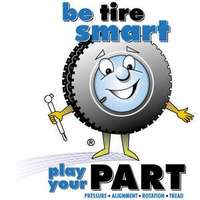Millions of Motorists at Risk - Survey Shows 11% of Vehicles With at Least One Bald Tire
RMA Urge Motorists to Check Tread; Costs Just A Penny
WASHINGTON, Nov. 19, 2009; A survey of more than 7,000 vehicles revealed that more than 11 percent had at least one bald tire, which can increase the risk of a crash, particularly in wet weather conditions that frequently occur during fall and winter months.
According to AAA, an estimated 33.2 million motorists will take to the road for Thanksgiving travel and that means nearly 4 million motorists could be at risk by driving on bald tires.
Additional alarming statistics revealed in a national motorist phone survey earlier this year found that 64% of car owners did not know how to check tread depth and 9% never check tread depth.
The surveys were sponsored by the Rubber Manufacturers Association (RMA), the national trade association of tire manufacturers in the U.S. RMA is urging motorists to regularly check tire tread depth and replace worn out tires before they become a serious safety risk.
"In this bad economy, drivers may be delaying necessary vehicle maintenance to save costs," said Charles Cannon, RMA president and CEO. "But that delay may cost you more dearly if worn out tires lead to a crash with injuries or fatalities."
According to RMA checking tread depth is simple and only costs a penny. To do the "penny test," take a penny; insert Abe Lincoln's head upside down into the tread. If you can see all of his head, your tire is 2/32nds of an inch deep or less and should be replaced.
Tires also have "wear bars" built into them. These are indicators that appear when you have worn your tread down to the limit. These indicators are raised sections spaced intermittently in the bottom of the tread grooves. When they appear "even" with the outside of the tread, it's time for tire replacement.
"Your tires literally keep your vehicle attached to the road," Cannon said. "Bald tires are dangerous because they cannot grip the road properly, they increase stopping distances and can contribute to skidding or loss of vehicle control."
Under wet weather conditions, bald tires can hydroplane, which can lead to a loss of vehicle control and increase the risk of a crash. When a vehicle hydroplanes, the tire is riding on a film of water.
Not only are too many motorists not paying attention to tread depth, they also are ignoring tire inflation pressure. Under inflated tires also pose a safety risk, wear out faster and increase vehicle fuel consumption.
A similar survey of more than 5,400 vehicles' tire pressure conducted in March-May 2009, RMA found:
-- Only 9% of vehicles had four properly inflated tires.
-- 50% of vehicles had at least one under inflated tire.
-- 19% of vehicles had at least one tire under inflated by 8 pounds per
square inch (psi.)
Tire inflation pressure should be checked every month and before long trips. To properly check tire pressure, motorists should check once each month; check tires when cold -- before the vehicle is driven and; use the vehicle manufacturer's recommended pressure found on a label located on the driver's door or door post or check the owner's manual.
While basic tire maintenance only takes a few minutes each month, many tire retailers nationwide offer tire pressure and tread depth check at no charge.
RMA collected tire tread depth information from more than 7,000 vehicles in 15 states between September 1 and November 3. The data was collected by several tire retailers that participate in RMA's Be Tire Smart -- Play Your PART tire maintenance education program.
The Rubber Manufacturers Association is the national trade association for the rubber products industry. Its members manufacture various rubber products, including tires, hoses, belts, seals, molded goods, and other finished rubber products. All RMA press releases are available at www.rma.org.



